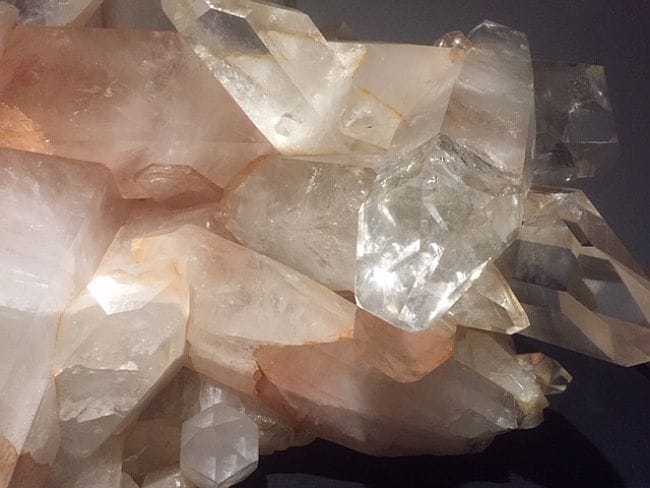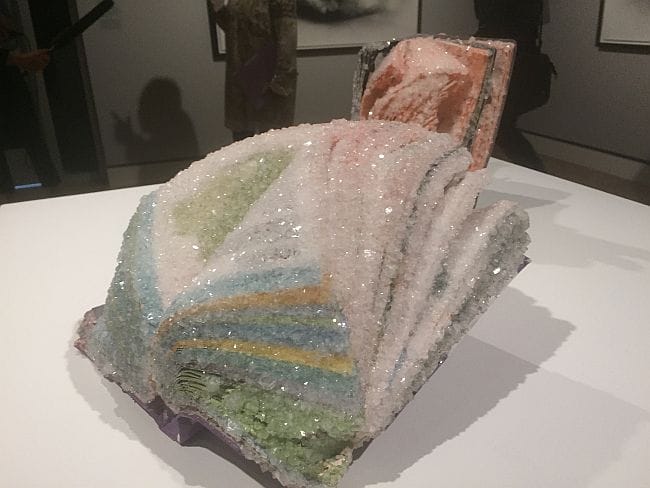

Uh oh...
It appears that you're using a severely outdated version of Safari on Windows. Many features won't work correctly, and functionality can't be guaranteed. Please try viewing this website in Edge, Mozilla, Chrome, or another modern browser. Sorry for any inconvenience this may have caused!
Read More about this safari issue.
A046_C009_02283D

Arkansas’s topography is rich with beauty; rivers and streams, ridges and mountains, delta flatlands… everything above the surface of the ground is photogenic in its way. But hidden below the surface is another kind of beauty that Arkansas is known for. There are over 300 types of minerals found in The Natural State, but quartz and diamonds are probably the stars of the show when it comes to tourism. It was only a matter of time before Crystal Bridges Museum of American Art in Bentonville curated a show featuring some of these items in their newest exhibition, Crystals in Art: Ancient to Today.

Crystals in Art features 75 objects that explore how crystals have captured the human imagination across time, place, and culture, and draw on the links between art, religion, science, and social status. Visitors to the exhibition will see sculpture, photography, etching, drawing, video, mixed-media, crystals as early tools, ritual objects, jewelry, decorative items, and more.
Artworks featured in the exhibition are on loan from museum collections nationwide including the Metropolitan Museum of Art in New York, the Smithsonian National Museum of Natural History in Washington, DC, the Philadelphia Museum of Art, J. Paul Getty Museum in Malibu, CA, the Andy Warhol Museum in Pittsburgh, among others, and private collections.

Included with the 10 breathtaking crystal specimens on display as part of the exhibition is one named The Holy Grail. Recorded as the largest crystal cluster ever mined in Arkansas, the cluster was found in 1931 in west-central Arkansas, an area rockhounds will recognize as being renowned for producing some of the largest and clearest quartz crystals in the world.
Two of my favorite pieces in the exhibition were a pair of books processed with borax to create crystals that turned the pages into what looked like a make-believe landscape inhabited by fairies. They reminded observers that crystals are not relegated to nature, but can also be created in laboratories, and even our own kitchens. How many of us have eaten rock candy on a stick? It’s made in a similar fashion – by allowing the natural processes of sugar and water evaporation to do their thing.

If you’re a fan of using crystals as tools in your personal spiritual or meditation practices, you might see an eye-roll on occasion when you mention your affinity for the stones. But you can tell those naysayers that the use of crystals is not a new-fangled idea. In fact, as the exhibition makes clear, their use can be traced back thousands of years.
“Crystals have captivated the human imagination since the beginning of time,” said Rod Bigelow, executive director and chief diversity & inclusion officer at Crystal Bridges. “In Crystals in Art, we expand our focus on American art to explore the full impact of crystal on monarchs, religious leaders, and artists. This exhibition is distinctive for the museum because Arkansas is the only place in North America where high-quality quartz crystal is mined. This exhibition gives us an opportunity to shine a light on the natural state.”

Lauren Hayes, Crystal Bridges Museum of American Art’s curator of contemporary art and curator of visual arts at the Momentary, co-curated the one-of-a-kind exhibition with Joachim Pissarro, Bershad professor of Art History at Hunter College and Director of the Hunter College Galleries, CUNY/City University of New York.
“This exhibition serves to investigate the surprising role of crystals in the arts through the ages,” said Haynes. “We have an opportunity to expand on the dialogue around the relationship between crystals and art and offer new insights.”

“As we began research at Crystal Bridges for this exhibition, we discovered endless numbers of possibilities, working through a wealth of crystal artifacts and artworks from around the world,” said Pissarro. “However, the wide span of crystals in art featured in this exhibition is really a testimony to the rise and fall of empires under which these artifacts were created, and one could even say that the continuous fascination with crystal serves as a common denominator between different cultural, ethnic, and religious groups.”

Crystals in Art is organized into five sections, each one focusing on a different aspect of crystal and how it has been perceived by various societies across humanity’s timeline:
- Section One: Sacred and Transcendent – The luminous, ethereal, and prismatic qualities of rock crystal have inspired and facilitated spiritual and religious devotion. This section includes crystal artifacts and artworks that speak to the material’s connections with transcendence.
- Section Two: Crystal Extravagance – From ancient China and Egypt to Medieval and Renaissance Europe, royal courts and wealthy patrons commissioned and acquired luxuriously worked pieces made of crystal as symbols of affluence and power. This section features objects from an array of countries and time periods.
- Section Three: Science and Mysticism – Since ancient times, crystal has played an important role in science, yet its mystical associations continue today. This section explores crystal as both a scientific material and a substance thought by some to have metaphysical properties through photography, sculpture, and more.
- Section Four: Crystallic Form – In the early 20th century, Modern artists mined the physical properties of crystal for a variety of avant-garde artistic explorations. Juan Gris and Pablo Picasso pushed the boundaries of perspective, presenting multiple, overlapping points of view in a style that became known as Crystal Cubism.
- Section Five: Crystal Universe – Less concerned with the formal properties of crystal, the artists in this section look at how the idea of crystalline refraction can serve as an optic to alter one’s personal perceptions—and perhaps erase some of our barriers to enhance our ability to see multiple perspectives.
For more information about Crystals in Art, and to see the complete schedule for the exhibition’s associated tours and activities, check out the program schedule for details. One in particular that sounds fascinating is Discover the Grounds. It’s hosted by Dr. Tom Paradise, professor of geosciences at the J. William Fulbright College of Arts and Sciences at University of Arkansas. We look forward to hearing what you think of the exhibition!
Cover image: Anthony James, Portal Icosahedron, 2019, Steel, glass, LED Lights, 80 × 82 × 82 in. Courtesy of the artist
We do the work.
You check your email.
Sign up for our weekly e-news.
Get stories sent straight to your inbox!









Like this story? Read more from Laurie Marshall
Many Arkansans know the name Miller Williams, the Arkansas-born poet who...
After July 4, we don’t have anything official to celebrate until Labor...
When I was a girl, my grandmother took me to visit the Ozark Native Craft...
Join the Conversation
Leave a Comment